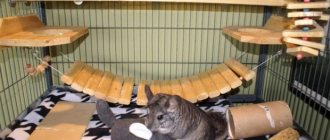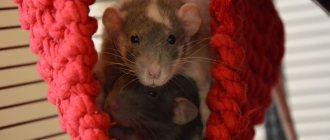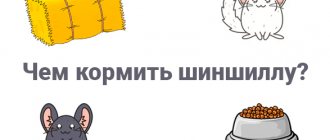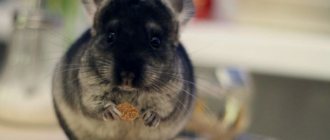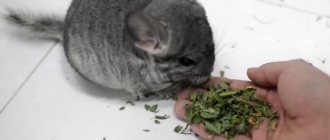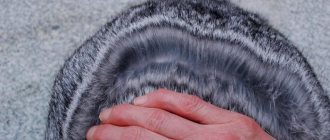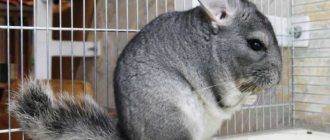Breeding chinchillas at home is not difficult, but it requires constant attention. It is important to know the basic rules that will help you from selecting a male or female to helping the cubs and the female after giving birth. Chinchillas are not monogamous animals; a male can mate with several females.
In this article you will find instructions, tips, videos and photos to help you mate chinchillas.
I hope that you will only breed chinchillas for sale and will not create a farm where they are killed for their fur.
Species diversity
There are quite a few breeds of chinchillas and a variety of colors. To breed chinchillas at home, you need to choose only valuable colors, which cost from 8,000 rubles per child.
To choose the right male, you need to know the name of your breed. The male's coloration should roughly match the male's to ensure you get the right coloration in the cubs.
The main breeds of chinchillas:
- Albino;
- White recessive;
- White dominant;
- Pink and white;
- Beige dominant;
- Agouti;
- Foggy;
- Motley, etc.
To know which species can be crossed and which cannot, look at the genetic table.
Features of choosing and purchasing breeding stock
Once you have prepared the room and cage, it is time to start purchasing livestock. For a home mini-farm, it is enough to purchase 2 males and 10 females. Such a set can produce 70-80 young animals in 1 year.
Many breeders and farms provide temporary males for mating - consider these options.
There is an opinion that chinchillas should be bred monogamously, i.e. form pairs and let them breed separately. This method has a number of advantages, but is more expensive.
Buy young animals only from large and trusted breeders. This way you will protect yourself from buying a sick animal. In addition, breeders can provide a guarantee and a breeding card.
Sexual maturity
The female is ready to mate at the age of 8 months, and the male is already at 6-7. A chinchilla at this age should already weigh more than 500 grams; if she has not gained that weight, then she is not yet ready for mating, because it will be difficult for her to bear offspring.
On average, chinchillas continue to give birth until they are 10-12 years old. A female can bring up to 2-3 offspring per year, and the number of cubs will always be different, from 1 to 5. There is no need to continuously mate animals, otherwise the female will age faster and lose her health.
Prospects for a chinchilla mini-farm
Breeding chinchillas is a business that requires systematic development. This is influenced primarily by the ability of animals to reproduce. To initially form a breeding core of 50 individuals, you will have to spend 2 years. Breeding individuals are more expensive and will cost you about 120 thousand rubles.
Females are kept for further production, males are exchanged or sold, thereby recouping all your costs.
You can reach the level of serious fur auctions with the ability to produce at least 5 thousand pieces of the highest quality furs per year. Until this moment, you can make good money by selling chinchillas for breeding to other farms or to hobbyists. The crisis of overproduction of this new branch of fur farming in our country does not threaten for at least another 50 years.
The cost of organizing a mini-farm will be 370 thousand rubles:
- equipment of the premises - 55 thousand rubles;
- purchase of breeding individuals – 120 thousand rubles;
- equipped cells – 85 thousand rubles;
- feed - 80 thousand rubles;
- other expenses (medicines, zeolite, electricity, etc.) – 30 thousand rubles.
If you produce 50 individuals in the first year and with an average cost of a chinchilla (or skin) of 6 thousand rubles, you will receive 600 thousand rubles. Thus, you will recoup your capital investments and receive a profit from sales. If you manage to get 100 chinchillas (pelts) in the second year, you will already receive 1.2 million rubles, and the net profit will be 980 thousand rubles. You can think about expanding the enterprise, hiring additional employees and further development prospects.
What you need to know to breed chinchillas
You should choose only strong and healthy chinchillas; only they will be able to produce good offspring for a long time. The second factor is beauty, it is important to take cute animals that people will buy with great desire. Beautiful parents will have beautiful babies.
Choose chinchillas with a thick and long coat, because their beautiful fur is why they are valued.
Cubs are born with their eyes open and they can see everything. They also have teeth and hair. A few days after birth, they are already able to feed themselves, but in order for them to grow properly they must be fed from their mother for 70 days. When the due date comes and the cubs have reached a weight of 200-300 grams, they can be placed in another cage and fed on their own. Until chinchillas are 100 days old, it is better not to give them to new owners; first you need to make sure that you separated them from their mother on time and that the animal does not have any diseases.
Do not forget that it is unacceptable to mate chinchillas from the same family. This will lead to unhealthy offspring.
Business registration
At the very beginning of your activity, you should not rush to register, because the business may not pay off at all, and you will have to pay taxes. The ideal form for such a mini-farm could be a private plot, but this is only if the entrepreneur owns at least 2 hectares. The advantages of this organizational form include the complete absence of taxes.
If production has already been established and the farm has begun to generate a stable income, then an individual entrepreneur should be registered so that the entrepreneur can report to the state about his activities and its profitability. Registration in this form will allow you to avoid bureaucratic red tape when selling fur.
In order to legalize an individual entrepreneur you must:
- An application from an entrepreneur with a request to register the activity in the organizational form of an individual entrepreneur;
- Russian passport and its copy;
- Duty payment receipt
With all these documents, the entrepreneur must come to the tax office himself and submit a package of documents for registration.
An entrepreneur engaged in chinchilla breeding should choose the unified agricultural tax or Unified Agricultural Tax as a tax system.
This system has a number of advantages:
- No VAT
- No need to pay for property and profit
- Tax rate is only 6% of net profit
Readiness for mating (estrus)
Like many animals, female chinchillas have a period of estrus (hunting) when they are ready to mate and, moreover, desire it. On average, estrus lasts from 2 to 5 days, then the mating process may become unsuccessful.
Determining whether a chinchilla has started hunting is not difficult. Her behavior gives her away very much; she begins to throw everything around and creates complete chaos in her cage. Along with active behavior, the female eats very little or not at all.
The second sign is external signs. The genitals swell and become bright pink.
Minor attributes for a pet
A large cage for your pet is a place where you can play and run around. It is convenient to arrange an area for fun and entertainment. The main thing is not to overdo it with the number of accessories for games.
For a chinchilla to rest, the following are suitable:
- Running wheel. It delights chinchillas; the main thing is to purchase an accessory with a fine mesh so that the animal’s paws do not get stuck while running.
- Hammock. A hammock stretched between the shelves is an excellent place to sleep or swing.
- Tunnel. Fuzzies love to hide in secret places, such as tunnels.
- Toys. Wooden rings or bells hung on a rope or wire and suspended from the ceiling will help the animal cope with sadness.
Reproduction
When breeding chinchillas at home, you need to take into account that the animal is nocturnal and they like to mate at night. It is very difficult to catch them during the process. Mating lasts a few seconds, so you can skip it if you just go to the kitchen for a drink of water.
In order for mating to be successful, it is necessary to place the male only during the female’s hunting period, otherwise the female may refuse her lover.
Sometimes, to make sure that mating was successful, you need to look into the cage. Usually, after mating, there are scraps of fur lying around in the cage, which are not observed during normal times.
After mating, it is necessary to place the female in another cage and monitor whether it is replenished or not. If a chinchilla becomes pregnant, she usually gains 30-50 in the first two weeks. In this case, you need to feed with regular food and standard portions, otherwise it may turn out that you simply overfed the female.
When you are convinced that the female is pregnant, you need to make her diet more varied. In the diet you need to increase the amount of vitamins and microelements that are necessary for the proper growth of the cubs. We have a separate article about the diet of pregnant chinchillas.
Sales of finished products
A female chinchilla can give birth until she is 12-15 years old, and they live on average 18-20 years. Sales of products can be multidirectional.
- Sale of culled animals. This method is suitable for any mini-farm organized at home. During selective work, “culling” will be common at first. In this case, the products can be sold to pet stores, resellers at bird markets and private hands. The animals you sell must not be weakened, healthy, only with defects in the fur and those who cannot be used for further breeding.
- Sales of breeding chinchillas. Animals with high value and high breeding qualities can be raised specifically for sale. Such goods are purchased by business and farm newcomers who lack good material for reproduction.
- Sale of fur. Mini-farms reach this level, in which at the end of the year there are up to 300 or more males. After all, products made from female skins are second-rate and come at lower prices. Clients at this level are fur auctions and fur tailoring studios.
A competent approach to organizing a business and following the rules in the care and maintenance of rodents can bring you a good and stable income. There is practically no competition in chinchilla breeding; the market is very wide. Any person interested in this can mate and raise chinchillas; it is not necessary to have experience or special education. The capital investment is minimal, the result will not take long to arrive.
Symptoms of approaching labor
It is necessary to monitor the female and know the symptoms of beginning labor. Before labor begins, it is necessary to change the bedding to fresh hay and remove the bathing suit.
The chinchilla gives birth on her own, she does not need help with this. The birth process is short and usually occurs in the morning, less often in the afternoon.
It is not difficult to determine that a female will give birth soon. If you keep an eye on your animal, you will immediately notice this change in behavior.
Symptoms of the onset of labor:
- The female's genitals begin to swell
- If you feel the female’s body, you will notice that the stomach seems to have sunk inward, and the ribs are sticking out.
- Nipples become enlarged and swollen
- The female is constantly stretching
- Prefers to sleep on his side
- Frequent urination
- Nose wet
- Cloudy discharge comes out of the vagina
How to breed chinchillas: postpartum complications and the possibility of miscarriage
The successful completion of childbirth does not mean that everything went well and monitoring of the female and her offspring can be relaxed. There remains a risk of various postpartum complications. If you seriously decide to breed chinchillas, then you should arm yourself with all the knowledge.
Important: Ideally, in case of any complications, you should contact a veterinarian! Self-medication can cost the life of the animal and its offspring.
- Weak lactation
That is, low milk production in the female, which can have various reasons. Most often it is associated with hormonal disorders, but may depend on the composition of the feed, the amount of fluid entering the body, and the individual characteristics of the female. An indicator of weak lactation is restless behavior of the cubs and weight loss. It is important to establish the cause and then take appropriate measures. Often lactation can be restored, but if this does not happen, the puppies will have to be fed artificially.
- Lack of maternal instinct
The case when a female abandons her cubs and even tries to destroy them is relatively rare. This happens more often in primiparous females; subsequently, they can normally feed litters and take care of the cubs. The most common way out of this situation is isolation from the female and artificial feeding.
- Mastitis
The formation of microcracks in the nipples, through which pathogenic microorganisms can penetrate, contributes to the development of mastitis - an infectious inflammation of the mammary gland. The nipples become red, harden and cause pain to the female, her body temperature rises, as a result of which she may refuse to feed the cubs. The cause of mastitis can also be stagnation of milk, in the case of a female raising one baby. In the initial stage of compaction, you can try to express milk, but this does not always help. In most cases, the use of antibacterial agents is indicated, although this does not have the best effect on the cubs. If purulent abscesses form, they are opened surgically.
Baby chinchilla
- Postpartum tetany
It is also called hypocalcemia or eclampsia; the cause is calcium deficiency in the female’s body, which can occur during multiple pregnancies. After all, calcium is a building material for fruits. This is an acute disease characterized by nervous spasms. If you notice unusual behavior of the female, her anxiety, lack of coordination of movements, strange throwing of her head, you should urgently contact a veterinarian for relief of the attack and further treatment.
Important: As an emergency before the doctor arrives, you can make a subcutaneous injection into the withers by dissolving 0.2-0.3 ml of 10% calcium gluconate in 1 ml of saline solution. As a preventive measure, a chinchilla should always receive high-quality food rich in microelements and vitamins, this is especially important during pregnancy.
- If your chinchilla had a miscarriage
The cause of miscarriage in chinchillas is most often violations in the maintenance of the pregnant female, a cramped cage, improper feeding, and a lack of essential nutrients. Much less common are viral infections or hormonal disorders. In the first case, the cause is easily eliminated, in the second, long-term treatment may be required, which should be prescribed by a veterinarian.
Newborns
Cell preparation
Based on these signs, it will be very easy to determine that labor will begin soon and it is necessary to prepare a cage for childbirth and cubs, because it is better not to disturb the female in the next few days.
It is necessary not only to change the hay, but also to remove all dangerous objects for the cubs. The babies are born with good eyesight, teeth and fur. They move actively, so you need to do everything to prevent them from harming themselves.
If your cage bars are too sparse, then figure out how to close them from the bottom so that the baby doesn’t get stuck in them and can’t crawl through.
It is necessary to feed children artificially only if the female does not have her own milk. A chinchilla produces milk 1-3 days after birth. If milk does not appear, the cubs will lie with their heads down and be lethargic. In this case, you will have to transfer the chinchillas to artificial feeding. Read in detail how often they need to be fed and where to get milk.
Also, do not forget to pay attention to the female. She needs a break from the cubs, who are constantly sucking milk and running around. You need to put her in another cage for a couple of hours or walk her. She will be incredibly grateful to you.
The cubs must stay with their mother for at least 70 days until they get stronger. During this entire period, the chinchilla has milk and only needs to be fed.
As soon as the babies get stronger, they can be placed in another cage and transferred to regular food. After a few days of living in a separate cage, it is necessary to examine the babies and assess their condition. If there are no problems, then you can begin to place them in other families.
Purchase of equipment
Cells
Cages will be required to house the animals. A number of requirements must be applied to them:
- Optimal sizes are 50/50/60 cm.
- Using fine mesh.
- An area of at least 0.3 sq.m per head.
- Durable material, steel will do.
- Safety.
- Ease of cleaning.
- Many experienced breeders arrange the cages in 2 rows of 6 cages. For this you need 18 sq. m from the area of the room.
Drinkers, feeders, senitsa
A mounted drinker is preferable. If you purchase a floor-mounted one, it must be heavy enough so that the animal cannot turn the vessel over.
The best option is a wire hay barn, from which it is convenient for the rodent to get grass without scattering food on the floor.
For chinchillas, it is recommended to use drinkers with a nipple system. Such a device will provide a round-the-clock supply of clean water to the animals and will not allow them to wet the bedding by splashing the liquid.
Sun lounger, house
The pet bed is usually placed on the back wall. The width of the lounger is at least 12 cm. Height from the floor is 25 cm.
The pet should have a place for privacy in the form of a cozy house. It is made without a bottom from rodent-safe wood species.
Pallet and litter
A tray with filler is installed on the floor. Sawdust, hay, shavings can act as filler. The litter should be replaced at least 2 times a week.
Bathing suit
Raising chinchilla livestock is impossible without a bathing bath - this is a container with volcanic sand for taking baths and cleaning the hair of the fur skins.
Animals are not bathed in water; sand helps keep them clean. The bathing suit should be spacious and have closed sides.
Toys, dental trainers
A running wheel, a walking ball, tunnels and everything that can be chewed with benefit for the teeth. Mineral stone is also used for grinding teeth
mineral stone required. You can use salt stones, chalk and pumice. The pet store has a wide range of entertainment for rodents. And there is a lot of information on the Internet about how to make toys from scrap materials.
Cleaning and disinfection products
Disinfection is carried out using special non-toxic agents or an ultraviolet lamp. During cleaning and disinfection, it is better to let the animals go for a walk or move them to a temporary home.
Other devices
To maintain the indoor microclimate you will also need:
- convectors for heating and maintaining optimal air humidity;
- 60 W lamps (1 piece per 10 sq.m.);
- air conditioner.
Female nutrition during pregnancy
To get healthy offspring, it is necessary to provide the female with balanced food and slightly increase the portion. Carefully monitor the quality of food so that the chinchilla does not get poisoning or other digestive diseases. Because treating them during pregnancy is doubly more difficult.
Be sure to include in your diet:
- High-quality hay, without debris, rot and mold
- Pelleted feed
- Keep the water clean
- Dilute dry food with fresh vegetables and herbs, but only in small quantities.
- Leaves and branches of trees
- Dried
Remember that you need to be careful with healthy nutrition. You may think that fresh vegetables are the ideal food for your pet, but you will end up with dangerous illnesses such as bloating, constipation or diarrhea. Juicy food is very dangerous for chinchillas, because it causes gas formation in the stomach, and she cannot get rid of them on her own. Therefore, succulent food should make up less than 25% of the daily intake of the total feed.
There are often recommendations on forums that chinchillas in the second phase of pregnancy should be given calcium gluconate. The dose is half a tablet; it helps the development of the fetus and strengthens its bone tissue.
You will find many articles on breeding and caring for chinchillas after birth on our website. Now I will give you links to the most important of them, so that you know all the nuances of chinchilla breeding and what it requires. Not many people are involved in the chinchilla breeding business; competition is quite low. This is due to the fact that the demand for them is not so huge, but there is always a hunt for beautiful colors, because it is almost impossible to find them in pet stores.
Possible risks
When planning this type of business, be sure to consider all possible risks. The biggest danger is the loss of animals. The disease of the entire livestock can lead to very unpleasant consequences. Despite the fact that chinchillas are not susceptible to diseases, they require careful care. When purchasing a new individual, monitor its behavior for a couple of days. Poor nutrition can lead to illness. Under no circumstances should you wash animals with water - this will make their fur worse.
Considering competition as a risk for doing business does not yet make much sense. Chinchilla breeding has not yet become widespread and this niche remains relatively free. However, it is still worth monitoring the state of the market in your region; perhaps there is a large breeder and seller of these animals very close by. Don't be afraid of competition, observe and learn from positive experiences.
